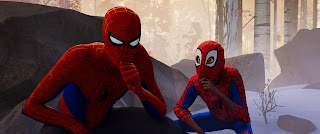It is more than a little disingenuous to pretend that
Mary Poppins Returns is anything more
than a thinly disguised remake of the original Mary Poppins (1964). At best you might get away with the modern
tendency to describe it as a ‘re-imagining’; what it is not, however, despite
the insistence of some of its stars, is a sequel.
Granted the film is set up as a sequel of sorts in
that that magical nanny, now played by Emily Blunt, reappears again at a time
of crisis for the Banks children. This time not for the little ones but the
original children who are now full-grown; Michael (Ben Whishaw) is a widowed and
penniless artist trying to care for his children while Jane (Emily Mortimer) is
a social activist implicitly waiting for a man to rescue her.
Mary arrives with the trusty Jack (Lin-Manuel
Miranda), a lamp lighter rather than Dick van Dyke’s chimney sweep, and – spit,
spot – all is sorted as you knew it would be from the moment Chekhov’s share certificate
made an appearance in the script.
It is a perfectly charming film but for me it lacks
the courage of its own convictions in that it can never quite free itself from
the shackles of the source material. Rather than carve out new narrative
territory they seem content to thrash around in the undergrowth of the old.
They have gone to the trouble of hiring Marc Shaiman
and Scott Wittman, the men behind Hairspray,
and they have written a score full of lively, jolly, and touching songs. However,
none of them is as good as any of the originals and, bizarrely, they all seem
deliberately designed to evoke the memory of the older, better, songs.
Can you Imagine
That, Trip a Little Light Fantastic, and The Place Where Lost Things Go, are thin facsimiles of A Spoonful of Sugar, Step in Time, and Feed the Birds and can’t hold a candle
to any of them. They’re decent songs, they’re just not classics.
This happens throughout the film where all the set-pieces,
including the live-action/animation mix, seem intended to remind you of the first
film. This is a shame because there is enough talent, imagination and energy here
to have come with a memorable film all their own.
It’s just that they seem determined to insist that
nothing has changed, or possibly will ever change, in Cherry Tree Lane so the
film is a little narratively hamstrung.
Emily Blunt’s Mary is a little icier than Julie
Andrews but the characterisation works, Miranda is a decent foil – even though
Dick van Dyke now no longer has the worst mockney accent in the movies – and Michael
and Jane have grown up just as you hoped they might as played by Whishaw and Mortimer.
Mary Poppins
Returns is an entertaining film and not without its charms. What it lacks,
I feel, is the passion and drive of someone like Walt Disney who, as we saw
from Saving Mr Banks (2013), was
determined to bring P.L.Travers stories to the screen. She wrote eight Mary
Poppins novels, I believe, surely someone at the Disney organisation could have
had the drive to take one of them and let Mary pick up her brolly and fly to a
new adventure.






